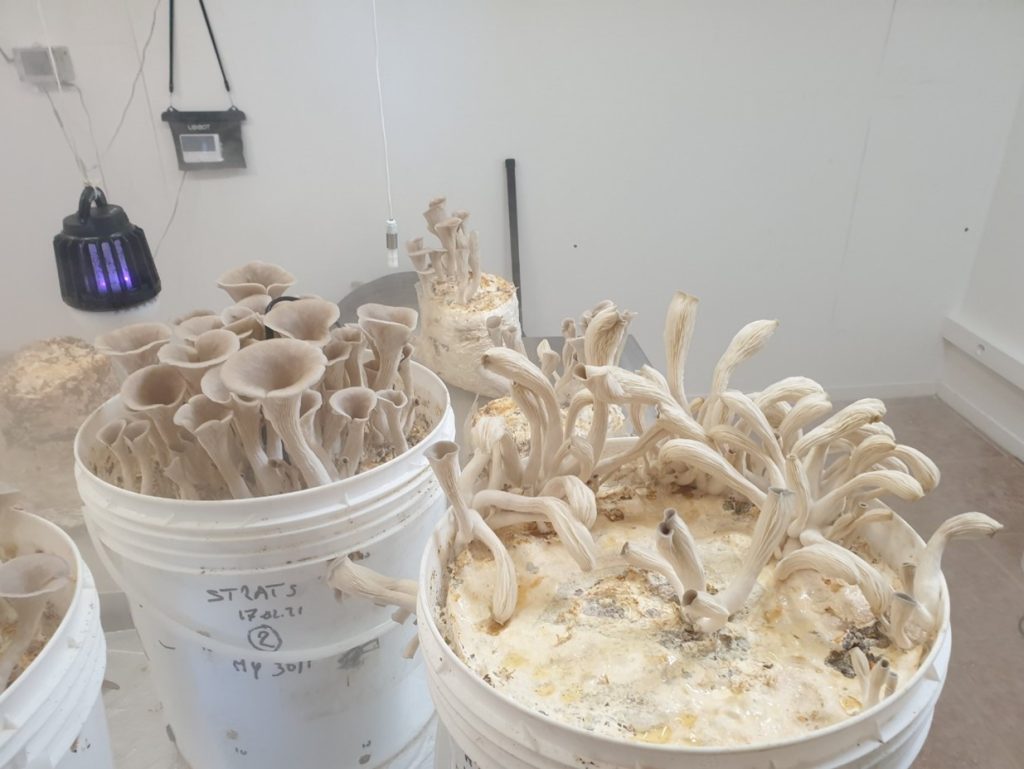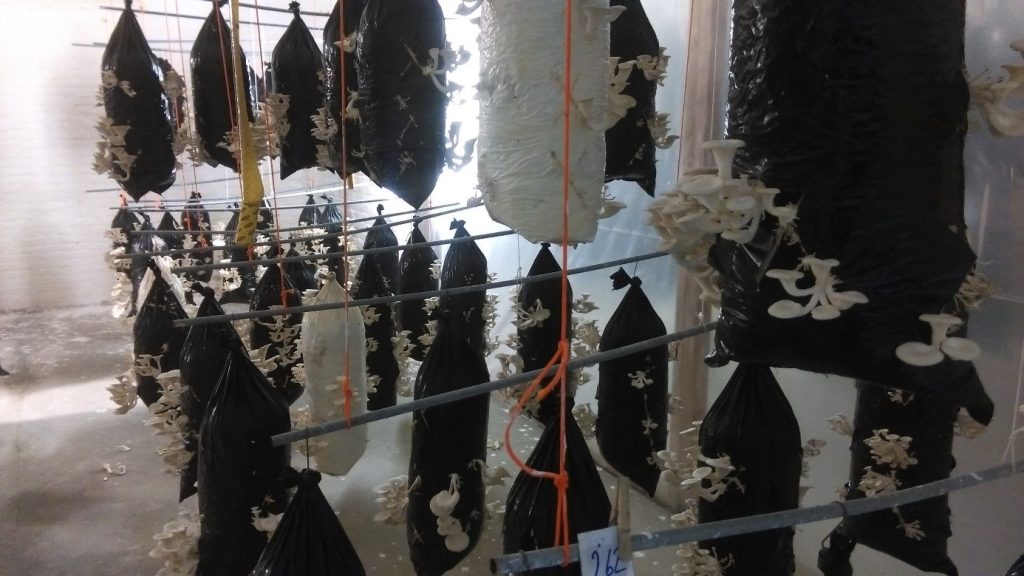And how to solve your mushroom growing problems.
Spawn Suppliers often receive desperate emails from clients suffering from pale mushrooms, species with brown spots, or funnel-shaped mushrooms with long stems, often paired with photos and the accusation that the spawn is of poor quality. If you didn’t know better, you’d likely think the same thing too. You can almost feel the frustration and the panic that comes with these messages.
But here’s the thing: Most of the time, the spawn isn’t the problem. What if it’s something you can fix with the right knowledge and a few small but crucial adjustments?

In fact, it’s typically something else. A lot of the issues growers face are tied to hygiene practices and growing conditions – specifically CO2 levels and humidity.
Though not mushroom growers ourselves, we have visited many mushroom farms and have seen these challenges firsthand. Over the years, we’ve learned that often the real culprit is not the spawn, but how the growing environment is maintained.
Let’s take a closer look at why your mushrooms might be struggling and how a few changes in your growing facility can save your harvest.
The hidden villains: Silent threats lurking in your growing facility
Imagine walking into your growing room, feeling hopeful, only to find a problem that’s invisible at first. Infections by imperfect molds or bacteria are the most common causes. These issues often start small – just a few brown spots here, a little discoloration there. But before you know it, they explode into full-blown problems, and by the time you notice, your mushrooms are already ruined.
This is the real-life nightmare that many mushroom growers face. You’ve spent months cultivating your crop, only for a single overlooked issue to derail everything. The problem might not always be with the spawn or the growing conditions you’re familiar with. Often, it’s something that’s been building up slowly, until the damage is too severe to reverse.
Here’s where the word H.Y.G.I.E.N.E. comes into play. A six-letter word that strikes fear into the hearts of growers when ignored. When hygiene is neglected, infections and malfunctions spread like wildfire. The worst part? They’re often invisible until it’s too late. And it’s not just hygiene that poses a risk – there are other pitfalls to watch out for too.
Let’s dive into some of the most common problems that can go wrong in your growing facility
- Imperfect Mold Spread: Mold can spread silently, contaminating the air, the tools, and even the substrate. It can take over the entire growing area before you realize what’s happening.
- Bacterial Infections: Bacteria like Pseudomonas tolaasii don’t just cause unsightly brown spots (the phenomenon is called ‘bacterial blotch’) - at worst they destroy the mushrooms, rendering them slimy and unmarketable. Excess humidity will create the perfect breeding ground for these bacteria, which dramatically lower the commercial value of your crop.
- CO2 Build-Up: Too much CO2 can lead to long, thin, trumpet-shaped mushrooms - often called “funnel-shaped mushrooms” - which are less desirable to buyers.
And the worst part? These issues don’t just result in financial losses. They’re also damaging to your reputation. Your reputation as a grower is at stake every time something goes wrong. Without proper hygiene, the problem only worsens with each harvest cycle, creating a never-ending spiral of disappointment and frustration.

Why the spawn is not always the problem
So it’s easy to blame the spawn when you see a batch go bad, but you already know that’s not always the problem. Many growers rush to make environmental adjustments or attempt to change the spawn, but without addressing hygiene and growing conditions, the problems will persist.
Here’s a reality check: spawn is only one part of the equation. While it’s important to use high-quality spawn, it’s equally important to ensure that your facility, tools, and environment are kept clean and that the growing conditions are optimal. Here’s why some common fixes don’t work:
Disinfectants:
Disinfectants are a must in any growing facility, but here’s the catch – they don’t kill everything. They kill most spores and bacteria, but never all of them. Without daily cleaning, contaminants will return.
Humidity:
Lowering humidity can reduce bacterial presence, but it won’t solve the root issue if hygiene isn’t properly maintained.
How to solve some of your mushroom growing problems
1. The key to fighting mold infections: hygiene first
The most effective way to combat mold infections is to start with hygiene. Picture it: a clean room, tools disinfected, surfaces wiped down, and no contamination lurking in the corners. It’s not just about cleaning – it’s about creating a culture of cleanliness that lasts. Here’s how to do it:
- Proper Waste Disposal: Get rid of any nutrient-rich waste like rotting mushrooms or grains immediately. The longer it stays, the more likely it is to attract contaminants.
- Daily Cleaning: Make it a habit to clean thouroughly inoculation rooms and -tools every day that they have been used. No exceptions.
- Disinfection: After cleaning, use effective disinfectants to keep contamination under control, by preventing the spreading of bacteria and molds.
- Mindset: Your entire company should be clean.
2. Combating bacterial infections
Here’s a nightmare scenario: you see a few brown spots on your mushrooms, which may or may not be slimy. Then the latter start to spread. Before you know it, all your mushrooms are slimy and unsellable. The culprit?
Pseudomonas tolaasii, a bacterium that thrives in high-humidity conditions. It can start small, but once it spreads, especially attached to mushroom spores, it’s a disaster. Finally, although invisible, they will be everywhere: on the floor, on the shelves or the racks, in the corners of the rooms, in the cracks of the walls.
Picture this: You notice condensation inside the plastic covers on your substrate. That means that the room temperature is lower than the substrate, and that is when bacteria thrive. Soon, you see the telltale signs of infection already on the primordia.
What now?
A few of the available solutions:
- Keep the room temperature under control during incubation: Maintain the room temperature close to the substrate temperature to prevent condensation and increasing bacterial growth.
- Maintain strict Hygiene: Thoroughly clean every surface during inoculation, incubation, and fruiting.
- Disinfect after cleaning: use effective disinfectants to keep contamination under control, by preventing the spreading of bacteria and molds.
- Switch to sporeless strains (only available for Pleurotus ostreatus): If contamination is severe, switch to a sporeless strain temporarily to prevent the bacteria from spreading with the spores.
3. Preventing ”funnel-shaped mushrooms with elongated stems”: The role of CO2
The formation of funnel-shaped mushrooms can be a major issue. You might think it’s just a weird genetic trait, but in most cases, it’s caused by a too high CO2- level / too low oxygen-level around the developing primordia. If that is the case, the mushrooms will form funnel-shaped hats on an elongated stem.
The Story: One grower shared with us how they thought they were doing everything right – until they realized they weren’t venting enough. High CO2 levels led to funnel-shaped mushrooms. They were producing a lot of mushrooms, but none of them were marketable.
A possible solution:
- CO2 Levels: Keep CO2 levels below 700 ppm by improving ventilation.
Although we know a lot about this topic, sometimes it’s nice to get a second opinion. So, we checked in with Jürgen Kynast, our friend, consultant in lignicolous mushrooms and expert at our Substrate & Wood Fungi Production Course. Here’s what he said:

Conclusion: Hygiene and good growing conditions are your best friend
By now, you’ve probably realized that hygiene is more than just an afterthought – it’s the foundation of healthy mushroom production. The issues many growers face, from brown spots to funnel-shaped mushrooms, often trace back to inadequate hygiene and poor growing conditions. It’s not always the spawn – sometimes, it’s the invisible things you can’t see, but they’re there, making all the difference.
You might have known that nothing is more variable than a mushroom. The conditions in your growing facility can drastically impact the success of your crop. By taking hygiene seriously and implementing the right growing conditions, you’ll be well on your way to producing consistent, high-quality mushrooms.